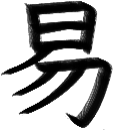易
易 may refer to any of the two yasashi kanji:
X6613 易 [2],
KanjiLiberal and
XF9E0 易 [3], KanjiConfudal; attempts to access 易 redirect here.
These characters have similar graphical representation, similar pronunciation and similar meaning.
易 may refer to someting simple (Yasashi) or, contrary, religious, occultic, magical, supernatural [4] ("Eki").
Confusion
Human, even if a native Japanese speaker, watching characters
易 and 易, is unlikely to guess:
Which of them is X6613?
Which of them is XF9E0?
Even software easy confuse these two characters: silently, without any warning, character 易 (XF9E0) may be replaced to character 易 (X6613). For this reason, the articles about character 易 is entitled XF9E0 (by its Unicode hexadecimal number); similarly, the article about character 易 is entitled X6613. The hexadecimal numbers as names are formed of the ascii characters; by default, the ascii names are not replaced by the software, at least, they are not replaced before to get the explicit order from the user.
In order to trace the automatic replacements and avoid confusions, some programming is necessary.
The Utf8 encoding of the characters mentioned can be calculated with the PHP program
ud.t
activated with command
php ud.t 6613 F9E0
The output is
6613 26131 易 易
Unicode character number 26131 id est, X6613
Picture: 易 ; uses 3 bytes. These bytes are:
XE6 X98 X93 in the hexadecimal representation and
230 152 147 in the decimal representation
F9E0 63968 易 易
Unicode character number 63968 id est, XF9E0
Picture: 易 ; uses 3 bytes. These bytes are:
XEF XA7 XA0 in the hexadecimal representation and
239 167 160 in the decimal representation
Graphic
Some softwere (linux) use different pictures for characters
X6613 易 and XF9E0 易.
Here is picture, how do they look together at a browser under Linux:

At your computer, they look like this:
易易
While printed with small font, character yasashi 易 may look similar to
characters tori (but not TORI) and/or sima and/or uma: 鳥, 岛, 島, 馬.
The main difference is, that the softwares
do not confuse characters of tori nor sima nor uma
(as they confuse X6613 易 and XF9E0 易).
Synonyms
安, yasui, "chip", "not expensive", easy.
Antonyms
高 (高価な), 多い (Expensive, difficult)
Jisho
易
8 strokes
Radical: sun, day 日
Parts: ノ 勹 日 勿
easy, ready to, simple, fortune-telling, divination
Kun: やさ.しい、 やす.い
On: エキ、 イ
Jōyō kanji, taught in grade 5 JLPT level N3 571 of 2500 most used kanji in newspapers
On reading compounds
易 【エキ】 type of cleromancy divination (described in the Book of Changes) performed with long sticks, The Book of Changes, Yijing, I Ching
易学 【エキガク】 study of divination
改易 【カイエキ】 change of rank
加工交易 【カコウコウエキ】 processing trade (importing all or part of raw and auxiliary materials, parts, components, accessories, and packaging materials in bond from a foreign company, and re-exporting the finished products after processing or assembly for distribution and sale by that foreign company)
易 【イ】 easiness
易々 【イイ】 easy, simple, plain
簡易 【カンイ】 simplicity, convenience, easiness, quasi-
難易 【ナンイ】 difficulty, relative difficulty
Kun reading compounds
易しい 【やさしい】 easy, plain, simple
やさしい文章 【やさしいぶんしょう】 easy (simple) writing
易い 【やすい】 easy, likely to ..., have a tendency to ..., easy to ...
Nihongomaster
Nihongomaster [5] suggests:
Definition of 易 easy ready to simple fortune-telling divination
Readings On'Yomi (音読み) エキ イ
Kun'yomi (訓読み) やさしい やすい
Popular Words With This Kanji
貿易, ぼうえき trade (foreign)
易しい, やさしい easy, plain, simple
容易, ようい easy, simple, plain
安易, あんい easy, simple, easy-going
簡易, かんい simplicity, convenience, easiness, quasi-
交易, こうえき trade, commerce
簡易保険, かんいほけん postal life insurance
容易い, たやすい easy, simple, light
平易, へいい easy, simple, plain
易, えき divination, fortune-telling
Kotobank
易 えき.. 古代中国におこった占いの方法。国家の大事を決するとき、殷(いん)(前18~前12世紀)では、亀甲(きっこう)、獣骨を焼いてできたひび割れの形によって、その吉凶を決した。亀甲獣骨卜占(ぼくせん)といわれるのがそれで、甲骨文字はそのときの卜辞である。周代(前12~前3世紀)になると甲骨卜占より占筮(せんぜい)のほうが多く行われるようになった。『易経(えききょう)』による占いである。『周礼(しゅらい)』によると、大卜(たいぼく)の職では、三易(さんえき)の法をつかさどったとある。三易とは、『連山(れんざん)』『帰蔵(きぞう)』『周易(しゅうえき)』である。『連山』は殷の前の夏(か)王朝の易であり、『帰蔵』は殷王朝の易であるといわれるが、今日ではなくなっていて、事実のほどは明らかでない。そして今日、易といっているのは、周代の易ということで、『周易』といわれているものである。もともと卜占の書であるが、その内容には生活の知恵が集約されているとともに、処世の哲学があり、後世、朱子学はこのなかに形而上(けいじじょう)学を形成した。
References
- ↑ 1.0 1.1
https://jisho.org/search/%23kanji%20%E6%98%93
https://jisho.org/search/%23kanji%20易 易 8 strokes Radical: sun, day 日 Parts: ノ 勹 日 勿 easy, ready to, simple, fortune-telling, divination Kun: やさ.しい、 やす.い On: エキ、 イ Jōyō kanji, taught in grade 5 JLPT level N3 571 of 2500 most used kanji in newspapers Words starting with 易 Words ending with 易 Words containing 易 External links Stroke order On reading compounds 易 【エキ】 type of cleromancy divination (described in the Book of Changes) performed with long sticks, The Book of Changes, Yijing, I Ching 易学 【エキガク】 study of divination 改易 【カイエキ】 change of rank 加工交易 【カコウコウエキ】 processing trade (importing all or part of raw and auxiliary materials, parts, components, accessories, and packaging materials in bond from a foreign company, and re-exporting the finished products after processing or assembly for distribution and sale by that foreign company) 易 【イ】 easiness 易々 【イイ】 easy, simple, plain 簡易 【カンイ】 simplicity, convenience, easiness, quasi- 難易 【ナンイ】 difficulty, relative difficulty Kun reading compounds 易しい 【やさしい】 easy, plain, simple やさしい文章 【やさしいぶんしょう】 easy (simple) writing 易い 【やすい】 easy, likely to ..., have a tendency to ..., easy to ... - ↑ https://util.unicode.org/UnicodeJsps/character.jsp?a=6613 易 6613 CJK UNIFIED IDEOGRAPH-6613 Han Script id: restricted confuse: 易 ..
- ↑ https://util.unicode.org/UnicodeJsps/character.jsp?a=F9E0 易 F9E0 CJK COMPATIBILITY IDEOGRAPH-F9E0 Han Script id: allowed confuse: 易 ..
- ↑ 4.0 4.1 https://kotobank.jp/word/%E6%98%93-36156 易(読み)えき (2021) 日本大百科全書(ニッポニカ)「易」の解説 易 えき // 古代中国におこった占いの方法。国家の大事を決するとき、殷(いん)(前18~前12世紀)では、亀甲(きっこう)、獣骨を焼いてできたひび割れの形によって、その吉凶を決した。亀甲獣骨卜占(ぼくせん)といわれるのがそれで、甲骨文字はそのときの卜辞である。周代(前12~前3世紀)になると甲骨卜占より占筮(せんぜい)のほうが多く行われるようになった。『易経(えききょう)』による占いである。『周礼(しゅらい)』によると、大卜(たいぼく)の職では、三易(さんえき)の法をつかさどったとある。三易とは、『連山(れんざん)』『帰蔵(きぞう)』『周易(しゅうえき)』である。『連山』は殷の前の夏(か)王朝の易であり、『帰蔵』は殷王朝の易であるといわれるが、今日ではなくなっていて、事実のほどは明らかでない。そして今日、易といっているのは、周代の易ということで、『周易』といわれているものである。もともと卜占の書であるが、その内容には生活の知恵が集約されているとともに、処世の哲学があり、後世、朱子学はこのなかに形而上(けいじじょう)学を形成した。 [安居香山]
- ↑
https://nihongomaster.com/dictionary/kanji/55/%E6%98%93
https://nihongomaster.com/dictionary/kanji/55/易 易 8 Strokes Radicals: 日 勿 JLPT Level 3 Definition of 易 easy ready to simple fortune-telling divination Readings On'Yomi (音読み) Kun'yomi (訓読み) エキ イ やさしい やすい Popular Words With This Kanji 貿易, ぼうえき trade (foreign) 易しい, やさしい easy, plain, simple 容易, ようい easy, simple, plain 安易, あんい easy, simple, easy-going 簡易, かんい simplicity, convenience, easiness, quasi- 交易, こうえき trade, commerce 簡易保険, かんいほけん postal life insurance 容易い, たやすい easy, simple, light 平易, へいい easy, simple, plain 易, えき divination, fortune-telling
Keywords
Confusion, Japanese, Jisho, Kanji, KanjiConfudal, KanjiLiberal, KanjiRadical, Kotobank, Nihongomaster, Tori, Sima, Uma, Unicode, X6613 易 , XF9E0 易 , Yasashi


